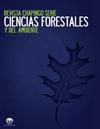热带森林生态系统服务:对其福利贡献和环境政策影响的不完善评估
IF 0.6
4区 农林科学
Q3 Agricultural and Biological Sciences
Revista Chapingo Serie Ciencias Forestales Y Del Ambiente
Pub Date : 2020-12-01
DOI:10.5154/r.rchscfa.2020.04.025
引用次数: 0
摘要
引言:生态系统服务、土地利用系统生产力和福利之间的具体关系是复杂的,人们对此知之甚少。目的:分析农业、林业和其他土地利用(AFOLU)部门的自然资本和福利之间的关系,以评估生态系统服务对农业、森林和渔业增加值(GDP[国内生产总值])的贡献,并分析政策影响。材料和方法:利用97个热带国家的土地利用分配变量、森林转型模型和土地利用GDP,采用线性回归模型和bootstrap方法估计了AFOLU部门的生产函数。分析了该函数的性质,计算了土地的最优配置。结果和讨论:森林生态系统对国内生产总值有直接贡献,也有间接贡献。直接效应表现为林地的部分弹性(P<0.05)。间接效应反映为生产规模(P<0.01)。农业的部分弹性显著高于林地的部分弹力(P<0.001),生产规模随着林地的枯竭而增加(P<0.005)。此外,最佳土地利用表明,75个国家森林盈余(1320万平方米),22个国家森林赤字(150万平方米。然而,这些贡献与农业土地生产力相比相形见绌。本文章由计算机程序翻译,如有差异,请以英文原文为准。
Forest ecosystem services in the tropics: an imperfect assessment of their contribution to welfare, and environmental policy implications
Introduction: The specific relation between ecosystem services (ES), land use systems productivity and welfare is complex and poorly understood.Objective: To analyze the relationship between natural capital and welfare in the Agriculture, Forestry and Other Land Use (AFOLU) sector to assess Ecosystem Services contribution to agriculture, forestry and fishing value added (GDP [Gross Domestic Product]) and analyze policy implications.Materials and methods: Using land use allocation variables, forest transition model and land use GDP for 97 tropical countries, the production function of AFOLU sector was estimated using a linear regression model and a bootstrap method. The properties of the function were analyzed, and the optimal land allocation was calculated.Results and discussion: There is a direct contribution and an indirect contribution from forest ecosystems to GDP. The direct effect is manifested through the partial elasticity of forestland (P < 0.05). The indirect effect is reflected through the production scale (P < 0.05). Partial elasticity of agriculture is significantly higher than partial elasticity of forestland (P < 0.05) and production scale increases as forestland is depleted (P < 0.05). In addition, optimal land use indicates that 75 countries have forest surplus (13.2 Mkm2) and 22 forest deficit (1.5 Mkm2).Conclusions: Forest ecosystems in the AFOLU sector in the tropics produce ecosystem services for society. However, these contributions are dwarfed by agricultural land productivity.
求助全文
通过发布文献求助,成功后即可免费获取论文全文。
去求助
来源期刊
CiteScore
1.20
自引率
16.70%
发文量
0
审稿时长
>12 weeks
期刊介绍:
The Revista Chapingo Serie Ciencias Forestales y del Ambiente (RCHSCFA) is a scientific journal that aims to raise awareness of high-quality research products related to forest, arid, temperate and tropical environments in the world. Since its foundation in 1994, the RCHSCFA has served as a space for scientific dissemination and discussion at a national and international level among academics, researchers, undergraduate and graduate students, forest managers and public/private entities that are interested in the forest environment.
All content published in the journal first goes through a strict triple-blind review process and is published in the following formats: Scientific Articles, Review Articles, Methodologies, Technical or Technological Notes.

 求助内容:
求助内容: 应助结果提醒方式:
应助结果提醒方式:


